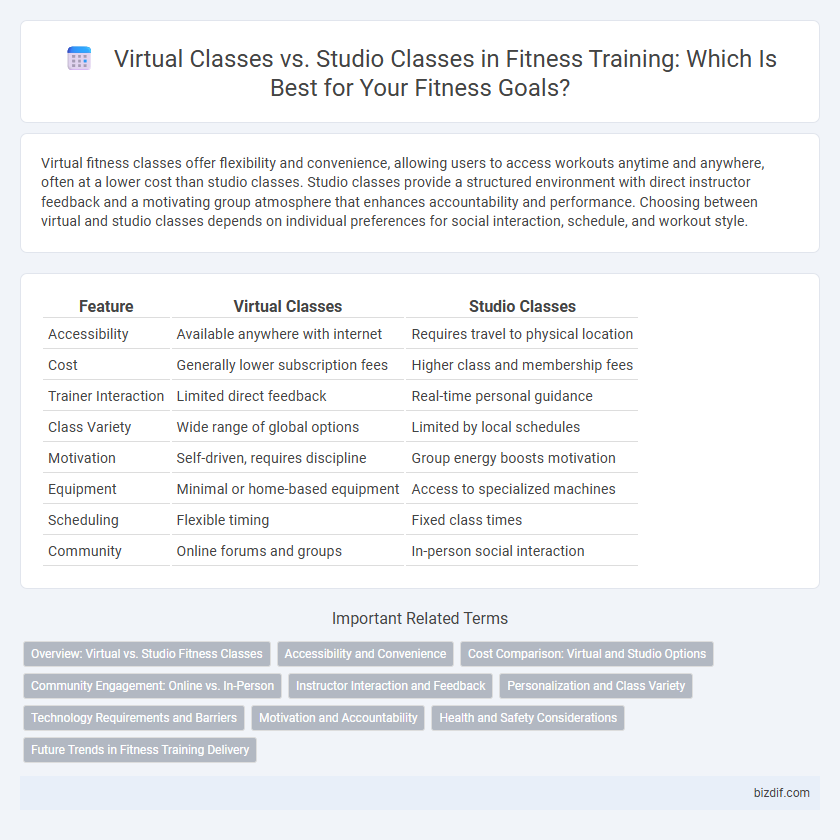Virtual fitness classes offer flexibility and convenience, allowing users to access workouts anytime and anywhere, often at a lower cost than studio classes. Studio classes provide a structured environment with direct instructor feedback and a motivating group atmosphere that enhances accountability and performance. Choosing between virtual and studio classes depends on individual preferences for social interaction, schedule, and workout style.
Table of Comparison
| Feature | Virtual Classes | Studio Classes |
|---|---|---|
| Accessibility | Available anywhere with internet | Requires travel to physical location |
| Cost | Generally lower subscription fees | Higher class and membership fees |
| Trainer Interaction | Limited direct feedback | Real-time personal guidance |
| Class Variety | Wide range of global options | Limited by local schedules |
| Motivation | Self-driven, requires discipline | Group energy boosts motivation |
| Equipment | Minimal or home-based equipment | Access to specialized machines |
| Scheduling | Flexible timing | Fixed class times |
| Community | Online forums and groups | In-person social interaction |
Overview: Virtual vs. Studio Fitness Classes
Virtual fitness classes offer flexible scheduling and the convenience of working out from home, making them ideal for individuals with busy lifestyles. Studio classes provide access to personalized coaching, immediate feedback, and a motivating group environment, enhancing performance and accountability. Both formats utilize expert-led workouts, but virtual classes emphasize accessibility while studio classes focus on hands-on interaction and community engagement.
Accessibility and Convenience
Virtual fitness classes offer unparalleled accessibility by eliminating geographical barriers, allowing participants to join workouts from any location with internet access. Studio classes provide in-person interaction and equipment availability but require commuting, limiting convenience for those with busy schedules. Online platforms enhance flexibility, enabling users to choose session times that fit their routines, making virtual training a more convenient option overall.
Cost Comparison: Virtual and Studio Options
Virtual fitness classes typically cost 30-70% less than studio classes due to eliminated overhead expenses like rent and utilities. Subscription-based virtual platforms often range from $10 to $30 per month, while in-person studio classes average $15 to $40 per session, sometimes requiring costly membership fees. Budget-conscious fitness enthusiasts find virtual classes a more affordable alternative without sacrificing access to professional instruction.
Community Engagement: Online vs. In-Person
Virtual fitness classes foster community engagement through interactive features like live chats, real-time feedback, and social media groups, enabling participants to connect globally despite physical distance. In-person studio classes offer a tangible sense of camaraderie through face-to-face interaction, shared physical space, and group energy that often enhances motivation and accountability. Both formats cultivate community, but virtual classes excel in accessibility while studio classes provide a more immersive, personal social experience.
Instructor Interaction and Feedback
Virtual fitness classes offer convenience but often limit real-time instructor interaction and personalized feedback, which can affect form correction and motivation. Studio classes provide direct, immediate instructor guidance, enhancing technique adjustment and fostering a more engaging, motivating environment. Participants in studio settings benefit from tailored feedback, promoting safer and more effective workouts compared to virtual formats.
Personalization and Class Variety
Virtual fitness classes offer extensive personalization options through adaptive algorithms, allowing tailored workouts that fit individual goals and fitness levels. Studio classes provide a broad variety of group workouts led by live instructors, fostering real-time interaction and motivation. Combining virtual and studio formats maximizes personalization and class variety, enhancing overall training effectiveness.
Technology Requirements and Barriers
Virtual fitness classes require reliable high-speed internet, compatible devices such as smartphones, tablets, or computers, and familiarity with digital platforms, which can pose barriers for individuals lacking technical skills or access to technology. Studio classes eliminate the need for personal tech setup but demand physical attendance and may limit participation due to location and schedule constraints. The integration of augmented reality (AR) and wearable tech is gradually enhancing virtual class interactivity while also raising the need for more advanced devices.
Motivation and Accountability
Virtual fitness classes provide flexible access to workouts but often lack the immediate social interaction that enhances motivation and accountability in studio classes. Studio environments foster a sense of community and real-time instructor feedback, which significantly boosts participants' commitment and effort. High engagement in studio classes correlates with improved consistency and goal achievement compared to the relatively isolated experience of virtual sessions.
Health and Safety Considerations
Virtual fitness classes minimize exposure to germs and viruses by eliminating the need for physical presence, reducing the risk of contagious illnesses. Studio classes, while offering direct instructor interaction and personalized feedback, require strict sanitation protocols, mask policies, and social distancing to ensure participant safety. Choosing between virtual and studio classes depends on individual health vulnerabilities and the ability of studios to enforce comprehensive health and safety measures.
Future Trends in Fitness Training Delivery
Virtual classes leverage advanced digital platforms and AI-driven personalized coaching, enhancing accessibility and convenience for diverse fitness levels. Studio classes continue to evolve by integrating immersive technologies such as augmented reality and hybrid models, offering enhanced social interaction and motivation. Future trends indicate a seamless blend of virtual and in-person experiences, maximizing engagement through data-driven customization and real-time feedback.
Virtual classes vs Studio classes Infographic

 bizdif.com
bizdif.com